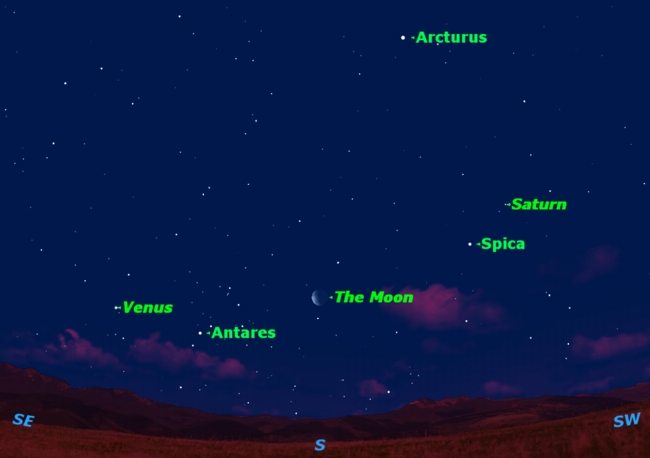Moon, Stars and Planets Offer Pre-Dawn Sky Show

If you get up an hour before sunrise tomorrow (Jan. 27) and have clear skies, you’ll be greeted by a spectacular array of stars and planets spread across the southern horizon with the quarter moon as a celestial centerpiece.
Most people lose track of the moon at this time of the month because it’s in the morning sky.You will see, spread in a gently curving arc, the bright planet Venus, the red giant star Antares (1.0), the moon (–11.8), the blue-white star Spica (1.0), and the planet Saturn (0.7). Above them all, directing the show, will be the orange star Arcturus (–0.7).
This sky map of the moon and stars shows how they may appear to skywatchers with dark skies and clear weather before dawn tomorrow. [Infographic: How Moon Phases Work]
The numbers following each object listed above indicate their expected brightness, weather permitting, on the upside-down magnitude scale used by astronomers.
On that scale, typical stars range from 1 (the brightest) to 6 (the faintest visible to the naked eye). Objects brighter than first magnitude are indicated by minus signs. So the moon, at magnitude –11.8, will be the brightest; Venus, at –4.3, second brightest, Arcturus at –0.7, next.
If you observe the moon with binoculars or a small telescope, you will be able to identify some of the craters we looked at two weeks ago, except now the light will be coming from the opposite direction. Watch over the next few mornings as the terminator sweeps westward, engulfing the craters in darkness.
While these stars, planets, and the moon will be symmetrically arranged tomorrow morning, things never stay put in the sky. The moon, in particular, moves about 13 degrees eastward every 24 hours.
Get the Space.com Newsletter
Breaking space news, the latest updates on rocket launches, skywatching events and more!
On Friday morning (Jan. 28), the moon will have moved from its central position to lie close to Antares. The next morning it will be between Antares and Venus, and Sunday (Jan. 30) between Venus and the horizon.
All the while, the lunar crescent will be narrowing as it heads toward new moon on Feb. 2.
This week is an excellent opportunity for early risers to view the dynamics of the moon’s movement against the background of the planets and stars.
This article was provided to SPACE.com by Starry Night Education, the leader in space science curriculum solutions.
Join our Space Forums to keep talking space on the latest missions, night sky and more! And if you have a news tip, correction or comment, let us know at: community@space.com.

Geoff Gaherty was Space.com's Night Sky columnist and in partnership with Starry Night software and a dedicated amateur astronomer who sought to share the wonders of the night sky with the world. Based in Canada, Geoff studied mathematics and physics at McGill University and earned a Ph.D. in anthropology from the University of Toronto, all while pursuing a passion for the night sky and serving as an astronomy communicator. He credited a partial solar eclipse observed in 1946 (at age 5) and his 1957 sighting of the Comet Arend-Roland as a teenager for sparking his interest in amateur astronomy. In 2008, Geoff won the Chant Medal from the Royal Astronomical Society of Canada, an award given to a Canadian amateur astronomer in recognition of their lifetime achievements. Sadly, Geoff passed away July 7, 2016 due to complications from a kidney transplant, but his legacy continues at Starry Night.












